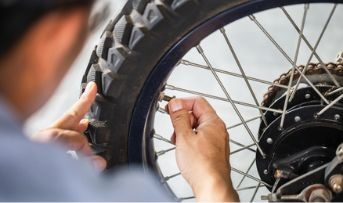General Insurance Blogs, Articles & Updates by - Magma HDI
Have us call you
- RENEW YOUR POLICY
- BUY NEW POLICY

Buying a new two-wheeler? Here are the important documents that you will need
Given the crowded riding conditions and slow-moving traffic in Indian cities, two-wheelers have always emerged as the top choice for daily commuting. They are perfect for city travel because they are simple to navigate through traffic and take up much less space to park and promise better mileage.
In congested areas, riding a two-wheeler can significantly shorten your commute and help you reach your destination in time. From economical city bikes or scooters to attractive sports machines, two-wheelers have an exciting range of categories and myriad options. For every diverse taste and expectation of a rider, a two-wheeler is available in the market. All one needs to do is thorough research before making the final decision.
Buying the first bike or scooter is a dream for many, and in this blog, we will discuss how one can achieve this by understanding the complete buying process and the documents required to purchase your first two-wheeler.
Once you select your two-wheeler, the next crucial step is the paperwork. Be prepared to submit the required documents that will be needed by the dealer, the bank (if you're taking out a loan), and the two-wheeler insurance provider. The documents that you must submit are listed below.
Documents required for vehicle registration:
● Passport size photograph
● Attested copy of ID proof- Driving Licence or PAN Card
● Proof of Permanent Residence (attested copies) – Passport, Voter ID Card, copy of insurance policy.
If any of the documents mentioned above are unavailable, you may give any of the documents listed below. Don't forget that the documents need to be properly attested:
● Electricity bill
● Phone bill (BSNL Landline)
● Ration card
● House tax receipt from the corporation
These are the extra documents you must present if you buy a two-wheeler in a city other than your residence. All supplied documents must be properly attested:
● Copy of registered rent agreement
● Copy of your landlord's electricity bill
● Letter from your employer
● Original affidavit
Documents required to buy a two-wheeler on EMI:
If you are planning an EMI option for your vehicle, you can finance your bike up to 100% and pay the balance back in simple, flexible EMIs. Depending on the lender, the interest rate, processing fee, EMI bounce costs, etc., for these loans may change.
Depending on the facility provided by the lender, the term of these loans may range from 6 to 60 months. The paperwork you might require to purchase a new bike on an EMI is listed below.
Documents required by salaried individuals:
● Proof of identity: Aadhar Card/Pan Card/Passport/Driving Licence/Voter ID and passport-size photos
● Proof of address: Driving Licence/Passport/Voter ID/Aadhar card/Utility Bill/Bank statement
● Income proof: Bank statements of the last 3 months, salary slips of the last three months/salary certificate/Form 16
Documents required by self-employed individuals:
● Proof of identity: Aadhar Card/Pan Card/Passport/Driving Licence/Voter ID and passport-size photos
● Proof of address: Driving Licence/Passport/Voter ID/Aadhar card/Utility Bill/Bank statement
● Income proof: Income Tax Return (ITR), last 3 months' bank statements
To legally ride your two-wheeler on public highways in India, you must have two wheeler insurance India. In addition to ensuring that you comply with the law, insurance gives you financial security in case of an accident. When you purchase a new two-wheeler, make it a point that you buy a reliable two wheeler insurance India policy that offers an additional safety net to your two-wheeled friend.
Click HERE to buy the best two wheeler insurance India policy.
Disclaimer: The information provided above is for illustrative purposes only. To get more details, please refer to policy wordings and prospectus before purchasing a policy.

Tips to keep your car’s battery healthy for a prolonged period
An often overlooked component in cars is their battery. It impacts the vehicle's longevity and hence should be taken care of. Intense temperature fluctuations have a significant adverse effect on its functionality. Besides this, several other factors lead to minimising battery efficiency.
Please remember that your motor insurance is also an important feature that helps with vehicle protection. With various subtypes, insurance providers offer solutions that protect your vehicle from the risk of obsolescence, depreciation, accidents, etc., as per the case. Motor insurance is one such safeguard for your cars against the financial costs of accidents. Motor insurance may provide a safety net against mishaps but cannot be considered a substitute for proper maintenance.
So, stated below are some tips to help you preserve battery life for long periods:
1. Don't leave your car unused for long periods
Long periods of idle time result in rapid charge loss. You may find the battery drained faster if you are an infrequent driver. For relatively short periods, your battery may give trouble while turning on, but after a prolonged period, it may drain entirely. In such cases, you must jump-start your vehicle or request a local mechanic to charge your battery.
In the long run, excessive idle time increases the risk of breakdowns. While the roadside assistance add-on to your motor insurance may help, it is best to maintain your battery health and avoid such situations altogether.
2. Minimise battery wastage when not in use
In stark contrast to the above point, you must also use your battery sparingly to reduce battery drain. This refers to when your engine is powered off, but other ancillary controls, like the music system, lights, air conditioning, heating, charging functions, etc., are in use. Turn off all supporting functions and accessories before you exit your vehicle.
3. Prioritise battery cleanliness
The battery is located under the bonnet for most models, while some recent designs may have specially allocated locations. Irrespective of its location, the battery usually allows room for accumulating flying dirt and debris. This stimulates corrosion and contamination, impacting the battery's functionality. Since an additional battery cover will affect the car's primary design, it is best not to tamper with it. Instead, regularly check under your bonnet and keep the battery and surroundings clean. Take your car for periodic servicing to ensure professional inspection and maintenance.
4. Factor in temperature changes
India being a tropical country, your car battery experiences extreme weather changes. Excessive heat results in rapid fluid evaporation, leading to lowered battery life. While you cannot eliminate evaporation, you can minimise it by limiting heat exposure and parking under shade whenever possible. During rains, parking in a protected space, regular inspection to identify signs of corrosion, and frequent servicing are ideal practices.
5. Don't overlook replacing schedules
A car is a complex mechanism. Since non-specialists do not know the minute details of its working, one must follow the manufacturer's instructions. Irrespective of how well you maintain your battery, you cannot extend its life beyond a point. Ideally, your battery may last up to 6 years in temperate environments. Usually, batteries in India last up to 3 years, while most battery manufacturers claim a product life of 4 years. Pay attention to signs of deterioration and replace your battery as suggested.
Apart from the above tips, maintaining fluid levels is a good practice to optimise battery life. Also, look out for the dashboard warning sign your car shows to reflect some issue with the battery. These measures help you keep your car's battery in the best shape. Additionally, purchasing motor insurance with a small repair add-on can help when battery replacement is needed.
Click HERE to buy a reliable motor insurance policy.
Disclaimer: The information provided above is for illustrative purposes only. To get more details, please refer to policy wordings and prospectus before purchasing a policy.

Working with less floor space? Multipurpose furniture is here to save the day!
Are you planning to add more furniture to your house but are confused about how to make the most of the floor space? All you need to do is choose furnishings carefully. Here's something you should know while buying furniture. Also, remember all wooden furniture items, including sofas, beds, dining tables, and other things, are covered by the best home insurance in India.
Here are some of our favourite small apartment space-saving furnishings to create a clutter-free, storage-heavy house.
1. Convertible study table
Every home with a tiny carpet area should include a folding study table as essential space-saving equipment. A range of metal and wooden options are available. In addition to being fashionable, a foldable study table will also be roomy for your flat. It can serve a variety of functions. They are minimalist and slick. Much room space is saved as they may be placed on the wall.
2. Kitchen table with a pull-out bench
Space-saving furniture designs that prevent the room from looking congested are frequently needed in small kitchens. Fortunately, this is simple to accomplish with an extendable kitchen table. You can use this table for multiple reasons, from handy base support while cooking to a lovely setting for a joyous breakfast.
3. Bedside table and under-bed storage
It's time to utilise that area if all under your bed is a collection of dust bunnies. A movable storage container can serve as both a nightstand and valuable storage. Roll it out before night and then back under the bed in the morning to conserve room on the floor. Invest in mobile storage containers that will fit beneath the bed perfectly.
4. Choose stackable chairs
You can look into ways to improve your furniture's functionality and invest in space-saving options. Stacking your kitchen chairs while not in use is an excellent illustration. It will help you effortlessly access extra space for other activities.
5. Storage basin with little space
A space-saving storage basin rack is the ideal organiser for your small apartment bathroom. Cover all your toiletries within the frame to keep them dry and protected from water splashes. This will save much space and ensure a clean environment for your necessities.
6. Convertible sleeping chair
Convertible sleeper chairs serve as excellent TV-viewing chairs during the day. They can spread out to make a bed at night. Consider a sleeper chair if you enjoy daytime naps or require an additional guest bed in a small house.
7. Space-saving desk
Every underused part of your room can be transformed into a specific workspace by adding a broad shelf or a sleek table top. Not all solutions for furniture storage need to be ornate or meticulously crafted.
8. Storage compartment for shoes
An attractive space-saving covered shoe rack will keep your shoes neatly sorted. They save a lot of space and are user-friendly. So that you may sit on it to tie your shoes, you can choose a shoe rack with a lower height. Or, you can turn it into a table and adorn it with your favourite vase or display piece.
Nowadays, people choose tiny homes since they are simpler to maintain and live in. Due to this, many homeowners are searching for practical and multifunctional space-saving furniture ideas and designs. There are countless designs for multipurpose furniture, such as sofas that can be made into beds, stools with storage, etc. Although they are more compact, these multipurpose furniture designs serve multiple functions. When it comes to having your own home, it's not just the appeal that matters but also the safety. Invest in the best home insurance in India and protect your property and belongings from mishaps.
Click HERE to buy the best home insurance in India.
Disclaimer: The information provided above is for illustrative purposes only. To get more details, please refer to policy wordings and prospectus before purchasing a policy.

A quick guide on traction control for beginners
As a beginner rider, the traction control can be a confusing and intimidating topic. However, it's essential to understand the basics of traction control to ride safely and confidently on your motorcycle. This blog will act as a quick guide on traction control for beginners, covering the basics, including what it is, how it works, and how to use it effectively.
1. What is traction control?
Traction control is a safety feature that helps prevent your motorcycle's wheels from losing balance and sliding out of control. It works by monitoring the speed of your wheels and adjusting the engine power output to prevent wheel slip. This is especially important when riding on wet or slippery surfaces, where it can be difficult to maintain traction.
2. How does traction control work?
Traction control works by using sensors to monitor the speed of your wheels. When your motorcycle's computer detects that one or both wheels are spinning too quickly, it reduces the engine power output to bring your wheels back under control. This is done by temporarily cutting off your engine's fuel supply or adjusting the throttle valve.
Some motorcycles have more advanced traction control systems. They can adjust the power output of individual wheels or even activate the brakes on specific wheels to prevent them from slipping. These systems are typically found on high-performance motorcycles and are more complex than basic traction control systems.
3. How to use traction control effectively?
Traction control is designed to help you maintain control of your motorcycle, but it's essential to use it effectively to get the most out of this safety feature. Here are some tips for using traction control effectively:
● Familiarise yourself with your motorcycle's traction control system
Before you hit the road, take some time to familiarise yourself with your motorcycle's traction control system. Read the owner's manual, and experiment with the system in a safe, controlled environment.
● Adjust the traction control settings to suit your riding style
Most motorcycles with traction control have adjustable settings that allow you to customise the system to your riding style. Some systems have multiple modes, such as a rain mode for wet conditions or a sport mode for increased throttle response. Experiment with these settings to find the right balance of traction control for your needs.
● Pay attention to warning lights and alerts
If your motorcycle's traction control system detects a problem, such as a malfunctioning sensor or a low battery, it will typically alert you with a warning light. Pay attention to these alerts and take action as needed to prevent further problems.
● Importance of regular maintenance
Regular servicing of your motorcycle can help keep the system functioning optimally. A qualified mechanic can check for any faults or issues and repair them before they cause damage to the system. Also, proper maintenance can prolong the system's life, saving you money in the long run.
● Proper riding techniques
Avoid sudden acceleration or braking, and maintain a consistent speed when riding. Proper gear shifting can also help improve your motorcycle's handling. Proper riding techniques can minimise the risk of accidents and ensure that your motorcycle's traction control system works effectively.
● Understanding the impact of road conditions
Road conditions can significantly impact the performance of your motorcycle's traction control system. Wet, slippery, or uneven road surfaces can reduce your motorcycle's grip. Your traction control system may need to work harder to maintain traction.
Traction control systems are designed to help improve the handling and performance of your motorcycle. You can ensure it works efficiently by paying attention to warning lights, adjusting settings, using proper riding techniques, and familiarising yourself with the system. Similarly, bike insurance is also essential for any motorcycle rider, and buying bike insurance online can offer a range of benefits. With bike insurance online, you can ensure that you and your motorcycle are protected from an accident or theft. Research different options and choose the policy with attractive premium and benefits.
Click HERE to learn more about purchasing bike insurance online.
Disclaimer: The information provided above is for illustrative purposes only. To get more details, please refer to policy wordings and prospectus before purchasing a policy.

Hand care tips for guitar aspirants to avoid injuries
Indulging in leisurely activities is an overlooked aspect of today's hectic lifestyles. With building pressures of being competent and work stress while handling societal expectations, it is essential to explore and identify areas of interest outside conventional academics, careers, etc. With the early onset of mental struggles with issues like depression and burnout, research has shown that engaging in at least one activity outside your regular schedule that allows you to enjoy your personal space is beneficial.
Learning instruments is one of the most popular activities taken up as a hobby. Learning to play the guitar is the most popular activity on many people's to-do lists. It is a relatively inexpensive hobby that can be learnt without an expert's guidance and does not require years of practice to reach the beginner's level of playing. However, there is always a risk of injury, considering the small fretboard, metal strings and fast wrist movements that need to be mastered.
Multiple factors come into play relating to your posture, wrist placement, plucking, and supporting hand placement that may result in injuries if not done correctly. Here are some tips to prevent injuries while playing the guitar.
1. Long durations of playing the guitar without adequate breaks:
Over practice causes more significant harm than good. While it may seem exciting to display your determination to learn the guitar by playing continuously without taking breaks, it is best not to do so.
There is no fixed duration that you should practise and then take a break after, but it is best to limit a practice session to 30-45 minutes and then take a 10-minute break. It also helps prevent neck or back injuries from sitting in the same position for long durations.
2. No warmup:
It is common to be excited and skip the fundamentals to learn advanced techniques. No matter what level of expertise, it is necessary to warm up before each playing session. This involves regular stretching and practising finger exercises on the fretboard. Multiple online resources can help prevent discomfort and increase your fingers' agility and precision while shifting chords and fingerpicking.
3. Excessive pressure:
Often seen in the case of beginner acoustic guitar players, it may seem challenging to produce sound on metal strings. It is natural to use excessive pressure on the strings in such a case as you try to learn better. However, as you practise, you must find the ideal amount of force, just enough to produce sound.
Excessive pressure applied during regular playing damages the fretboard and may cause discomfort to your fingers. It may even lead to the tearing of the fingertips' skin. Understand that ideal pressure results in the formation of calluses, not injuries.
4. Proper posture:
Getting the basics right is the most important thing to understanding any skill. Sitting upright will allow you to keep your spine, neck, arms and wrist strain-free. If you feel any specific pain repetitively as you practise, it is best to get the guidance of an expert or stand before a mirror to identify and correct the issue.
In case you feel irregular pains in your wrist, it is best to get it checked by a doctor and use supporting devices like a wrist brace upon professional recommendation. Icing the wrist and regularly massaging the area can help significantly reduce inflammation and pain. Since one cannot eliminate injuries, taking preventive care and buying comprehensive personal accident insurance India is necessary to cover the financial burden.
Click HERE to buy reliable personal accident insurance India.
Disclaimer: The information provided above is for illustrative purposes only. To get more details, please refer to policy wordings and prospectus before purchasing a policy.

Customisation tips to reflect your style through your bike
The rapidly growing two-wheeler market has adapted to the personalised needs of motorcyclists. Riders prefer to make a statement with their uniquely customised bikes that turn heads wherever they go. Once only considered modes of convenient private commute, bikes translate to much more in modern times.
If you wish to apply your style preferences to your bike, you can use several customisation options.
Caution: Check your 2 wheeler insurance policy
However, study your 2 wheeler insurance policy's fine prints to verify if it covers accidents post modifications. Generally, most 2 wheeler insurance providers reject claims raised for bikes that have been primarily modified. This is due to the enhanced risk of accidents from tampering with the manufacturer's original bike tunings.
Considering this general caution, read on to find out how you can customise your two-wheeler to suit your style better:
1. Rear-view mirrors
Rear-view or side mirrors are an integral part of the riding experience. They facilitate traffic visibility which helps make better judgements. These mirrors come in various shapes, sizes, colours, and styles to fit every rider's fancy while being extremely functional!
2. Handlebar
Although subtle, one of the first things that catch the viewer's eye when looking at a two-wheeler is its handlebar. Essential for maintaining posture and a comfortable grip, you can opt for different handlebars to alter the overall look of your bike. Choose between the wide bar of cruisers or narrow to straight bars that allow greater grip for adventurous riding.
3. Grips
If the overall feel of your handlebar is perfect and needs no change, but you wish to add a pop of colour to it, change the grips! Firmly glued on, you may have to force the existing grips off. You may approach a local mechanic for help to pry them off and get a new pair in a different colour, design, texture, or with additional features.
4. Fuel tank pad
A fuel tank pad is a cost controller and prevents the evaporation of your bike's fuel. Such a functional component set at the centre of the bike's chassis can add extra oomph to your daily ride. Choose among a vast range of colours and textures that prevent scratches to the gas tank due to scraping of metal accessories of your riding gear.
5. LED lights
Adding LED lights along the body frame in strategic positions or replacing your head and tail lights with LED variants will make you catch everyone's eye. LED strip lights are a quick fix for the same effect.
Listed above are some customised practices that global motorcyclists use to set their bikes apart from conventional designs we commonly see on roads. Wishing to incorporate personal style preferences across all your belongings is typical. However, when dealing with two-wheelers, it is essential to draw limits to prevent altering the original build and functionality. This helps preserve its efficiency in the long run.
Before making significant alterations relating to shifters, add-on storage racks, etc., one must consider their 2 wheeler insurance policy wordings to stay within its coverage scope. Irrespective of the scale of modifications, ensure that you purchase 2 wheeler insurance to protect yourself against accidents.
Click HERE to buy 2 wheeler insurance that fits your requirements.
Disclaimer: The information provided above is for illustrative purposes only. To get more details, please refer to policy wordings and prospectus before purchasing a policy.

Did you know that your bathing habits can impact your digestion
Our elders followed a healthy lifestyle and had a long lifespan, however, life expectancy has been going down in recent years. A big reason for this is the inability to follow a healthy lifestyle due to our busy schedules and poor dietary habits. We are more prone to falling ill and catching several seasonal and life-threatening diseases. The majority of health conditions rely on your eating habits and digestion. Did you know that even your bathing habits can impact your digestion? This has been certified by both Ayurveda and modern science.
Let us see how our bathing habits impact our digestion.
Say no to shower immediately after a meal.
Whenever we eat a meal, our body rushes blood to the digestive system. This helps it in the digestion process. As a result, heat is generated inside the body to break down the food.
Ayurveda’s point of view:
According to Ayurveda, this heat is the fire element inside us. Whenever we eat something, it gets activated and helps in the digestion process. Taking a shower has a cooling effect on the body. It automatically lowers the body temperature. The fire element or the heat in the body cools down, and the blood flow also slows down. This directly impacts the digestive process, in turn, and slows it down considerably. Hence, taking a shower after a meal harms our digestive system.
Medical science’s point of view:
The same fact is corroborated by medical science but differently. It says that taking a shower right after a meal slows down the blood flow because of the cooling effect. Our body starts working harder to maintain a standard temperature to help in the digestion process. The blood that should help in the digestion process is diverted to other parts of the body. This results in the slowing of the digestive process.
It may also cause acidity and uneasiness, and you may feel a sense of nausea. Our bodies may start feeling dull and sluggish. You might have a comforting sleep after a shower, but it will be bad for your digestive system. A bath after a meal can increase your heart rate and may add to your discomfort when your stomach is full. Therefore, medical science also discourages a bath right after a meal.
Type of meal.
As mentioned above, bathing right after a meal is bad for our digestive system. However, how bad it varies with the type of food that we have. A meal high in protein or fat may result in bloating and slowing down our digestive process. Having lighter food such as fruits, salad or soup will have a lesser negative effect on our digestive system. Eat what suits your stomach the best while also taking care of your body’s nourishment.
Waiting time.
It is not that we cannot take a bath all day after having a heavy meal. We need to wait for some time after we have had a heavy meal so that the food gets time to digest. This waiting time may vary from person to person, but generally, a gap of 30 minutes is advisable for taking a bath after a meal.
It is best to take a bath early in the morning to feel fresh, relaxed and rejuvenated. If we cannot take a bath before breakfast, we should avoid taking it right after we have a meal due to the above-mentioned reasons.
Indigestion results in multiple problems, such as upset stomach, stomach pain, nausea, etc. Chronic indigestion can be a big problem and lead to other serious illnesses. Hence, we should invest in the best health insurance policy in India to protect ourselves and our families. A health insurance policy can be a saviour as treatment costs have skyrocketed in recent years in India. It will provide us security in times of illness and keep our savings intact.
Click HERE to buy the best health insurance policy in India.
Disclaimer: The information provided above is for illustrative purposes only. To get more details, please refer to policy wordings and prospectus before purchasing a policy.

Decoding the markings on your bike tyre’s sidewalls
Have you ever looked at your motorcycle's tyres and wondered what all the numbers and letters on the sidewall mean? Tyre sidewall markings can be confusing, but they contain essential information about your tyres to help you maintain and replace them correctly.
This blog will decode the markings on your bike tyre's sidewalls to help you better understand them. So, without further delay, let's get started.
1. Understanding tyre size markings
One crucial aspect of understanding the markings on your bike tyre's sidewall is to know how to read the size markings. The first set of numbers and letters is the size marking. It typically appears as a combination of numbers and letters, such as 120/70 R17. The number 120 refers to the tyre's width in millimetres, whereas 70 denotes the aspect ratio or profile of the tyre, representing the sidewall's height as a percentage of the width.
For instance, if the width is 120mm, the sidewall height would be 70% of 120mm, which equals 84mm. Lastly, the number 17 represents the wheel rim's diameter in inches. Choosing the correct tyre size for your motorcycle is crucial to prevent performance, handling, and tyre failure issues.
2. Tyre load index and speed rating
The load index and speed rating are necessary markings on your bike tyre's sidewall. The load index indicates the maximum weight the tyre can carry, while the speed rating indicates the top speed that the tyre can handle.
A number on the sidewall represents the load index. This number ranges from 1 to 279 and corresponds to a specific weight limit for the tyre. You can find a load index chart online to determine the weight limit of your tyre.
The speed rating is represented by a letter on the sidewall. This letter ranges from A to Z and corresponds to a specific speed limit for the tyre. Again, you can find a speed rating chart online to determine the maximum speed limit of your tyre. You must select a tyre with the appropriate load index and speed rating for your motorcycle.
3. Tyre manufacturing date code
Every tyre has a manufacturing date code on its sidewall. The code consists of four digits, the first two representing the week and the last two representing the year of manufacture. For example, if the code reads "1719," the tyre was produced in the 17th week of 2019.
It is important to note that tyres have a lifespan of about six years, even if they appear to be in good shape. They should be replaced six years after their initial manufacturing date, regardless of their wear and tear. Therefore, checking the manufacturing date code is critical in determining the tyre's age and deciding when to replace it.
4. Importance of proper tyre maintenance
Proper tyre maintenance is essential for safe and efficient riding. Tyres that are underinflated, overinflated, or worn out can affect your bike's handling and performance, increasing the risk of accidents. Regularly checking tyre pressure, tread depth, and overall condition can ensure that your bike's tyres are in good shape and provide optimal performance. Additionally, tyre rotation and alignment can help distribute wear evenly, extending its lifespan.
Decoding the markings on your bike tyre's sidewalls is critical for ensuring the safety and longevity of your bike. Proper tyre maintenance is also essential for safe and efficient riding. The safety of a bike is incomplete without bike insurance. Robust bike insurance can provide financial protection in case of accidents or damages. As a responsible rider, you must know these factors and take the necessary precautions to keep your bike in shape.
Comprehensive bike insurance covers not only damages to your bike but also liabilities arising from accidents involving third parties. It is important to note that bike insurance policies often have specific coverage for tyre damages or replacements, which can help offset the cost of replacing worn-out or damaged tyres.
Click HERE to learn more about the benefits of purchasing bike insurance.
Disclaimer: The information provided above is for illustrative purposes only. To get more details, please refer to policy wordings and prospectus before purchasing a policy.


